Australia, Daw Island: An Outpost of Nature
Daw Island is an outpost of Nature, a lonely island at the very eastern end of the remote Recherche Archipelago and impossible to visit without a stout vessel and the courage to face Australia’s south coast.
Published 3 years ago
A long Covid winter sharpened their need for adventures far away from viruses, media and authority, so long time Australian cruisers Jack and Jude Binder decided to share their experiences of some of the most remote places they have visited around a continent that has the world’s longest continuous coastline.
Droplet of Land
We’re guessing that you’ve never heard of this droplet of land that pops out the turbulent Southern Ocean 20 miles from Isrealite Bay in Western Australia.

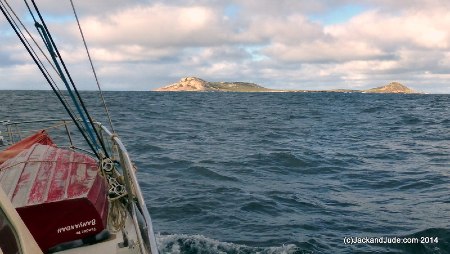
- Daw Island, off the southern coast of Western Australia.
A few years ago, we sailed past it on our way west, but didn’t stop as we had wind for many more miles. So this time when going east, we were keen to explore Daw Island. Especially after Ted, our tuna fisherman friend in Albany told us that Daw Island once had a tuna processing ship stationed there during the fishing heydays of the 1970s.
Outpost of Nature
Today, Daw Island is an outpost of Nature, a lonely island at the very eastern end of the remote Recherche Archipelago, impossible to visit without a stout vessel and the courage to face Australia’s south coast. Very few visit, mostly fishermen and few yachtsmen, but hardly any pleasure boats venture out that far from help.
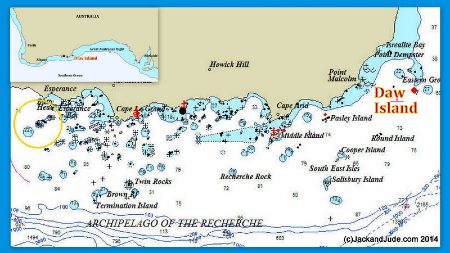

At Daw, Nature dominates. And that makes this place special. Cute comical sea lions, majestic sea eagles, plump geese, muttonbirds, penguins, and deadly snakes all coexist with a myriad of other birds and critters living away from man and his needs. At Daw Island, these creatures raise their families unmolested.
In our adventure machine we have traveled far and wide to find Nature living where man does not exist. We sailed to the middle of the Coral Sea to observe thousands of sea birds undisturbed by man. This time we pitted our skills against the wild Southern Ocean that can create gigantic waves from storms gathering fury in the freezing waters of Antarctica. Down under Australia, far away from the built up centres of Albany and Esperance, there are a thousand islands. Some just rocks partly submerged but still home for many creatures.
Dodging Rocks and Underwater Shoals
Our sail to Daw was perfect, except we often altered course to dodge tiny rocks jutting from the ocean. And we were frightened and in awe when great swells broke over underwater shoals we couldn’t see. But the wind held, and forty miles on Daw became visible as a dull grey shadow with white water flashing high into the sunlight. Still flying full sail after forty-eight miles, we were conning our way into calmer water, Jack atop the coach house searching for hidden dangers.
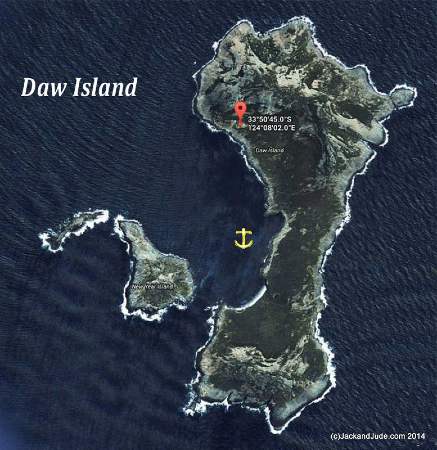
Shaped like a boomerang, Daw Island has tall massifs, but is not surveyed. Its sister island, New Year, is only a pinprick on navigational charts. On the slopes before us, the sun lit up the bright red, yellow, and orange colours of succulents.
Don’t Ignore the Warning Signs
Donning thick walking pants, boots, and wet weather gear we landed on the only sand beach and straight away noticed a sign warning of deadly snakes. We know a bit about these creatures, so Jack cautiously took the first track thorough shallow bush that lead to another then another until we reached the saddle looking both to windward and into our anchorage.
The Banyandah looked so beautiful all alone in the half cauldron, while on the weather side occasional white caps on a slate-grey sea below a leaden sky drew our attention to an approaching black curtain of rain. Feeling the invigorating fresh breeze fired up our desire to reach the island’s highest peak and along the way our cameras captured gigabytes of this beautiful Earth.
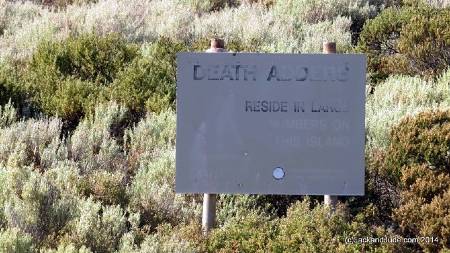
- “Death Adders Reside In Daw Island”
Rain came just as we reached a rock cave near the end of the main island, and ducking under its crude cover we watched several Cape Barren Geese honk and gesture while trying to figure us out.
The Birds Rule Here
High overhead, a pair of majestic sea eagles soared as if they owned the sky. They were using Nature’s forces to swirl and look down on everything like the very best spy camera. What a life. No bills to pay. No bureaucratic red tape. Mating for life, sharing the same hunting range, in the morning and evening, they would roost together and sing. While, at other times, they would soar on Earth’s energy to spot a tasty treat. And then their super sharp talons would lift enormous fish from the sea. They are indeed talented, unique creatures.
White-bellied Sea Eagles, Australia’s second largest raptor after the giant Wedge Tail Eagles, is listed as Threatened in Victoria and Vulnerable in South Australia and Tasmania. Their main threat, human disturbance to its habitat, both from direct human activity near nests which impacts on breeding success, and from removal of suitable trees for nesting.
The adult White-bellied Sea Eagle is a distinctive bird with its white head and breast, and tail. Their upper parts are grey and the black under-wing flight feathers contrast with the white coverts. Like many raptors, the female is slightly larger than the male, and can measure up to 90 cm (35 in) long with a wingspan of up to 2.2 m (7 ft), they weigh 4.5 kg (10 lb). Their call, a loud goose-like honking.
After the shower passed, Jack eagerly pushed up the last ridge connecting the two peaks, with a part of his route following a rock ledge that fell sharply into the sea. That might prove dangerous for Jude’s wonky knee, so she took a higher route through scrub where upon putting an un-gloved hand down for support, a snake struck at her. You can imagine her fright. Daw Island is a long way from help.
NOTE: Daw Island did not plot correctly on our CMAP charts.
Jack and Jude Binder
SV Banyandah
……………………………………………………………………………………………………………
See more “Off the Beaten Path” articles and resources here.
………………………………………………………………………………………………………………………………………
About the Authors
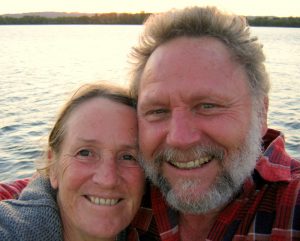

Their blog is filled with simple ideas for making life afloat more fun, safe, and comfortable, including links to online videos, Cruising Guides, and DVDs and Books that they have produced, plus a page on products that served them well during 200,000 miles of ocean travel.
The Sailing Adventures of Jack and Jude
………………………………………………………………………………………………………………………………………….
The opinions expressed in this article are the author’s own and do not reflect the view of Noonsite.com or World Cruising Club.
Related to following destinations: Albany, Australia, Esperance, Western Australia
Related to the following Cruising Resources: Off the Beaten Path






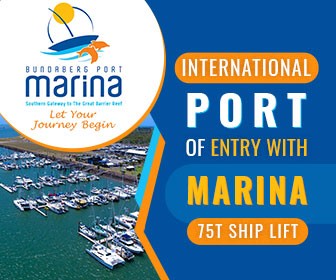

Loved the story. Brought back memories . In March 2013 we set off from Adelaide in our Spray , Gratis, headed to Fremantle.
A TC came ashore around Karratha then headed south inland and flew down exeting near esperance, where it met up with a weak Antarctic low. The system hit us about 30hrs out from Daw island . We had to turn north east and run with 50+knts and 6-8m seas . Next day we made Israelite bay where we rested for a day then on to Point Malcom for another day before finally setting back on course for esperance we saw the Island but did not head ashore . i wish we had. Thanks you for sharing the story
Bob & Karyle S/V Gratis
http://www.gratisaustralis.com
Reading yoru story I wish we had.